George Washington Bridge
The George Washington Bridge is a double-decked suspension bridge spanning the Hudson River, connecting Fort Lee in Bergen County, New Jersey, with the Washington Heights neighborhood of Manhattan in New York City. It is named after Founding Father George Washington, the first president of the United States. The George Washington Bridge is the world's busiest motor vehicle bridge, carrying a traffic volume of over 104 million vehicles in 2019, and is the world's only suspension bridge with 14 vehicular lanes.
The bridge is owned by the Port Authority of New York and New Jersey, a bi-state government agency that operates infrastructure in the Port of New York and New Jersey. The George Washington Bridge is also informally known as the GW Bridge, the GWB, the GW, or the George, and was known as the Fort Lee Bridge or Hudson River Bridge during construction. The George Washington Bridge ...Read more
The George Washington Bridge is a double-decked suspension bridge spanning the Hudson River, connecting Fort Lee in Bergen County, New Jersey, with the Washington Heights neighborhood of Manhattan in New York City. It is named after Founding Father George Washington, the first president of the United States. The George Washington Bridge is the world's busiest motor vehicle bridge, carrying a traffic volume of over 104 million vehicles in 2019, and is the world's only suspension bridge with 14 vehicular lanes.
The bridge is owned by the Port Authority of New York and New Jersey, a bi-state government agency that operates infrastructure in the Port of New York and New Jersey. The George Washington Bridge is also informally known as the GW Bridge, the GWB, the GW, or the George, and was known as the Fort Lee Bridge or Hudson River Bridge during construction. The George Washington Bridge measures 4,760 feet (1,450 m) long and has a main span of 3,500 feet (1,100 m). It was the longest main bridge span in the world from its 1931 opening until the Golden Gate Bridge in San Francisco opened in 1937.
The George Washington Bridge is an important travel corridor within the New York metropolitan area. It has an upper level that carries four lanes in each direction and a lower level with three lanes in each direction, for a total of 14 lanes of travel. The speed limit on the bridge is 45 mph (72 km/h). The bridge's upper level also carries pedestrian and bicycle traffic. Interstate 95 (I-95) and U.S. Route 1/9 (US 1/9, composed of US 1 and US 9) cross the river via the bridge. U.S. Route 46 (US 46), which lies entirely within New Jersey, terminates halfway across the bridge at the state border with New York. At its eastern terminus in New York City, the bridge continues onto the Trans-Manhattan Expressway (part of I-95, connecting to the Cross Bronx Expressway).
The idea of a bridge across the Hudson River was first proposed in 1906, but it was not until 1925 that the state legislatures of New York and New Jersey voted to allow for the planning and construction of such a bridge. Construction on the George Washington Bridge started in September 1927; the bridge was ceremonially dedicated on October 24, 1931, and opened to traffic the next day. The opening of the George Washington Bridge contributed to the development of Bergen County, New Jersey, in which Fort Lee is located. The upper deck was widened from six to eight lanes in 1946. The six-lane lower deck was constructed beneath the existing span from 1959 to 1962 because of increasing traffic flow.
The bridge sits near the sites of Fort Washington (in New York) and Fort Lee (in New Jersey), which were fortified positions used by General George Washington and his American forces as they attempted to deter the occupation of New York City in 1776 during the American Revolutionary War. Unsuccessful, Washington evacuated Manhattan by ferrying his army between the two forts.[1][a]
By the end of the 19th century there were more than 200 separate municipalities along the lower Hudson River and the New York Bay, with no unified agency to control commerce or transport in the area[3] and no fixed crossing. The first was proposed in 1888 by civil engineer Gustav Lindenthal, who later became New York City's bridge commissioner.[4] The Hudson and Manhattan Railroad and the Pennsylvania Railroad opened three pairs of tubes under the lower Hudson in the 1900s.[5] The first vehicular crossing across the lower Hudson River, the Holland Tunnel, was opened in 1927, connecting Lower Manhattan with Jersey City.[6][7]
Planning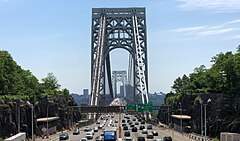 George Washington Bridge looking east from Fort Lee, New Jersey
George Washington Bridge looking east from Fort Lee, New JerseyA vehicular bridge across the Hudson River was being considered as early as 1906, during the planning for the Holland Tunnel.[8] Three possible locations for a suspension bridge were considered in the vicinity of 57th, 110th, and 179th Streets in Manhattan,[9] with others rejected on the grounds of aesthetics, geography, or traffic flows.[8][10] In 1920, English architect Alfred C. Bossom proposed a double-decker bridge with room for vehicular and railroad traffic near 57th Street in Midtown Manhattan. The same year, Othmar Ammann and Gustav Lindenthal proposed a vehicular and railroad bridge to 57th Street in Manhattan, topped by an office building on the Manhattan end that would have been the world's tallest.[11] Lindenthal's plan failed because it did not receive permits from the United States Army Corps of Engineers or approval from the city, and because Midtown Manhattan real estate developers and planners opposed the plan. Ammann unsuccessfully attempted to convince Lindenthal to build his bridge elsewhere, without a tower atop the bridge's terminus.[12] In January 1924, the New York State Chamber of Commerce voted against the 57th Street location in favor of another upstream.[13] Despite this, Lindenthal proposed that a bridge be built there, and carry 16 railroad tracks and 12 lanes of automotive traffic.[14]
Meanwhile, Ammann became chief engineer of the Port of New York Authority (now the Port Authority of New York and New Jersey), which was created in 1921 to oversee commerce and transport along the lower Hudson River and New York Bay.[3] He had disassociated himself from Lindenthal's proposal by 1923, conducting his own studies on the feasibility of a bridge from 178th Street in Fort Washington, Manhattan, to Fort Lee in New Jersey.[12] Ammann's advocacy for the Fort Washington–Fort Lee bridge gained support from both New Jersey governor George Silzer and New York governor Alfred E. Smith by mid-1923.[3] [12] In May 1924, Colonel Frederick Stuart Greene, the New York Superintendent of Public Works, announced a plan to construct a suspension bridge between Fort Lee and Fort Washington. At that location, both sides were surrounded by steep cliffs (The Palisades on the New Jersey side, and Washington Heights on the New York side). Thus, it was possible to build the bridge without either impeding maritime traffic or requiring lengthy approach ramps from ground level.[15]
A New Jersey state assemblyman introduced a bill for the Hudson River bridge that December.[16] This bill was passed in the New Jersey Assembly in February 1925.[17] After an initial rejection by Silzer, the Assembly made modifications before passing the bill again in March,[18] after which Silzer signed the bill.[19] Around the same time, the New York state legislature was also considering a similar bill.[20] A dispute developed between New York civic groups, who supported the construction of the Hudson River Bridge; and the Parks Conservation Association, who believed that the bridge towers would degrade the quality of Fort Washington Park directly underneath the proposed bridge's deck.[21][22] In late March 1925, the chairman of the Parks Conservation Association noted that the proposed New York state legislation would provide for the actual construction of the bridge, rather than just the planning.[23] Ultimately, the Hudson River bridge bill was passed in the New York state legislature, and Smith approved the bill that April.[24]
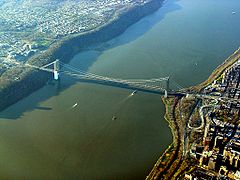 Aerial view of the bridge surrounded by cliffs on either side
Aerial view of the bridge surrounded by cliffs on either sideIn March 1925, Silzer asked Ammann to devise preliminary plans for the Hudson River bridge. Ammann found that the width of the Hudson River decreased by more than 1,000 feet (300 m) when it passed between Fort Lee and Fort Washington. The ledges of Fort Lee and Fort Washington were respectively 300 and 200 feet (91 and 61 m) above mean water level at this point, which was not only ideal geography for a suspension bridge, but also allowed the bridge to be high enough to give sufficient clearance for maritime traffic.[20] However, the differing heights meant that a large cut had to be made through the Fort Lee ledge so that the bridge approach could be built there.[25] The same month, the New Jersey legislature asked for funds for test bores to determine if the geological strata would support the bridge.[20] In response to continuing concerns from park preservationists, Ammann stated that placing the New York suspension tower anywhere else would make the bridge look asymmetrical, which he believed was a worse outcome than placing the tower within the park.[26]
The states conducted a study in mid-1925, which found that the Hudson River bridge would be able to pay for itself in twenty-five years if a 50-cent toll were to be placed on every vehicle.[27] After funding was secured, surveyors began examining feasible sites for the future bridge's approaches in August 1925. By law, the New York end of the Hudson River Bridge could only be constructed between 178th and 185th Streets, and the New Jersey end had to be built directly across the river.[25] Geologists made 300-foot (91 m) test bores on the New Jersey side to determine if the site was feasible for laying foundations for the bridge.[28] Othmar Ammann was hired as the bridge's chief engineer.[29] In Ammann's original plans for the bridge, which had been published in March 1925, he had envisioned that the bridge would contain two sidewalks; a roadway that could carry up to 8,000 vehicles per hour; and space for four railroad tracks, in case the two North River railroad tunnels downstream exceeded their train capacity.[20] Cass Gilbert was hired in January 1926 to design architectural elements for the Hudson River bridge, including the suspension towers. The bridge design had yet to be finalized, and its cost could not even be estimated at that point due to the complexity of factors.[30]
Gilbert released preliminary sketches of the Hudson River bridge that March; by then, the architect had decided that the span would be a suspension bridge.[31] The sketch accompanied a feasibility report that Ammann and other engineers presented to the Port of New York Authority, which was to operate the bridge. The central span was to be 3,500 feet (1,100 m) long, longer than any other suspension bridge in existence at the time, and 200 feet above mean high water. The bridge would initially carry four lanes of vehicular traffic and sidewalk lanes; the plans called for three additional phases of expansion, culminating in an eight-lane bridge deck with four rapid-transit tracks underneath. The span would be supported by two towers, each 650 feet (200 m) tall.[32][12] There would also be space to build a second deck in the future below the main deck.[33] Ammann's team also found that the most feasible location for the bridge was at 179th Street in Manhattan (as opposed to 181st or 175th Streets). This was both because the 179th Street location was more aesthetically appealing than the other two locations, and because a 179th Street bridge would be cheaper and shorter in length than a bridge at either of the other streets.[32] At this point in the planning process, the Hudson River bridge's estimated cost was $40 million[31] or $50 million.[32] Because of the proposed bridge's length, engineers also had to test the strength of materials, including suspension cables, that were to be used in the span.[34][35][36] Ammann's research department constructed scale models of various designs for the bridge and tested them in wind tunnels.[36]
By late 1926, one engineer predicted that construction on the Hudson River bridge would start the following summer.[37] In December 1926, the final plans for the bridge were approved by the public[38] and by the War Department.[39] The Port Authority planned to sell off $50 million worth of bonds to pay for the bridge, and the initial $20 million bond issue was sold that December.[40] Further issues arose when the New Jersey Assembly passed a bill in March 1927, which increased the New Jersey governor's power to veto Port Authority contracts. Smith, the New York governor, and Silzer, the now-former New Jersey governor who had been appointed Port Authority chairman, both objected to the bill since the Port Authority had been intended as a bi-state venture.[41][42] Afterward, the then-current New Jersey governor A. Harry Moore worked with legislators to revise the legislation.[43] The revised law was ultimately not a significant deviation from the Port Authority's practice at the time, wherein the Port Authority was already submitting its contracts to New Jersey government for review.[44]
ConstructionThe George Washington Bridge's construction employed three teams of workers: one each for the New Jersey tower, the New York tower, and the deck.[45] The construction process was relatively safe, although twelve or thirteen workers died during its construction.[46][45] Of these, three were killed when the foundation for the New Jersey tower flooded; a fourth worker was killed by a blast at the New Jersey anchorage; and the others died because of their own carelessness, according to Port Authority records.[45]
First contracts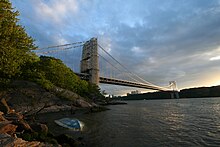 The bridge, looking south at sunset from the New York side of the Hudson River
The bridge, looking south at sunset from the New York side of the Hudson RiverIn April 1927, the Port Authority opened the first bids for the construction of the Hudson River bridge. It was specifically seeking bids for the construction of the New Jersey suspension tower's foundation.[47] The Manhattan suspension anchorage's location was still undecided at this time.[48] A bid for the New Jersey tower was awarded later that month.[49] In May, the Port Authority opened more bids for the construction of the bridge's approaches and anchorage on the New Jersey side.[50] Dredging operations on the Hudson River, which would allow large ships to pass underneath the bridge, also started that May.[51] By late August, the Port Authority had started condemning plots of land for the bridge's approaches.[52]
Montgomery B. Case, the bridge’s chief construction engineer,[53] began construction on the Hudson River bridge on September 21, 1927, with groundbreaking ceremonies held at the sites of both future suspension towers.[54][55] Each tower was to have a base with a perimeter measuring 89 by 98 feet (27 by 30 m), and descending 80 feet into the riverbed. The riverbed around the towers' sites was dredged first, and then steel pilings were placed in the riverbed to create a watertight cofferdam. The cofferdams for the bridge were the largest ever built at the time.[56][57] In early October of that year, the Port Authority received bids for the construction of the bridge deck. There were two main methods being considered for the span's construction: the cheaper "wire-cable" method and the more expensive "eyebar" method.[58][59] The wire-cable method, where the vertical suspender wires are attached directly to the main cables and the deck directly, would require a stiffening truss to support the deck. The eyebar method, where the suspender wires are attached to a chain of eyebars (metal bars with holes in them), would be self-supporting.[60][61] Ultimately, the Port Authority chose the wire-cable design because of costs, and it awarded the contract for constructing the deck to John A. Roebling Sons' Company.[62][59][60] The corresponding contract for manufacturing the steel was awarded to the McClintic-Marshall Company.[63] The first serious accident during the bridge's construction occurred in December 1927, when three men drowned while working in a caisson on the New Jersey side.[64]
Towers and anchorages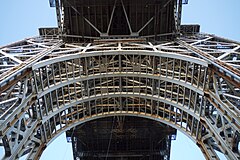 The Manhattan suspension tower, seen from below
The Manhattan suspension tower, seen from belowBids for the Manhattan suspension tower were advertised in March 1928.[65] At this point, 64% of the total projected worth of construction contracts had been awarded. The piers that provided foundation for the New Jersey suspension tower and approaches were being constructed.[33] The cliffs on both sides of the river were high enough that only minimal bridge approaches were required on either side. The towers' foundations could reach at most 190 feet (58 m) below mean low water, where the foundations would hit a layer of solid rock.[66] In May 1928, builders started drilling a 50-foot-deep (15 m) cut through the Palisades on the New Jersey side so that the Hudson River bridge approach could be built.[67] By June 1928, half of the money earned during the previous year's $20 million bond sale had been spent on construction.[68] By that October, nearly all blasting operations had been completed. The suspension tower on the New Jersey side had been constructed to a height of 250 feet (76 m), and the tower on the New York side was progressing as well.[69] The suspension towers consisted of 13 segments, each of which were almost 50 feet high.[56]
The New York anchorage required 370,000 short tons (330,000 long tons; 340,000 t) of concrete, being freestanding, while the New Jersey anchorage was blasted into the Palisades.[46] By March 1929, the concrete structure of the New York anchorage had been completed, three months ahead of schedule. The anchorage on the New Jersey side, which had been fully bored, consisted of two holes that had been bored 250 feet into the face of the Palisades. On the New Jersey side, 225,000 cubic yards (172,000 m3) of rock had to be blasted out to make way for the New Jersey approach. The suspension towers were nearly complete at the time of the report; only 100 feet of each tower's height remained to be built. Anchors were being placed in the two holes that were being drilled for the New Jersey anchorage, and this task was also nearing completion.[70]
In April, the Port Authority acquired the last of the properties that were in the path of the bridge's Manhattan approach.[71] Plans for the Manhattan approach were approved by the New York City Board of Estimate around the same time. The approach was to consist of scenic, meandering ramps leading to both Riverside Drive and the Henry Hudson Parkway, which run along the eastern bank of the Hudson River at the bottom of the cliff in Washington Heights. The bridge would also connect to 178th and 179th Streets, at the top of Washington Heights. A third connection would be made to an underground highway running between and parallel to 178th and 179th Streets; this connection would become the 178th–179th Street Tunnels, and would later be replaced by the Trans-Manhattan Expressway.[72] The original plan for the approach to the underground highway stated that the approach would be made using a monumental stone viaduct descending from the span at a 2.2% gradient.[57] The Port Authority started evicting residents in the approach's path in October 1929.[73] The same month, the Port Authority sold the final $30 million in bonds to pay for the bridge.[74]
The plans for the Hudson River bridge's Fort Lee approach were also changed in January 1930. Originally, the bridge would have terminated in a traffic circle,[75] a type of intersection design that was being built around New Jersey during the 1920s and 1930s.[76] However, the revised plans called for a grade-separated highway approach that would connect to a traffic "distributing basin" with ramps to nearby highways.[75] The total cost of land acquisition for the bridge approaches on both sides of the Hudson River exceeded $10 million.[77]
Cable spinning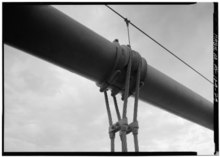 A close up view of a vertical suspender cable, which is connected to the larger main cable with what is called a "saddle"
A close up view of a vertical suspender cable, which is connected to the larger main cable with what is called a "saddle"After the towers were completed, two temporary catwalks were built between the two suspension towers.[78][56] Then, workers began laying the bridge's four main cables, a series of thick cables that stretch between the tops of the two towers and carry what would later become the upper deck. The first strand of the first main cable was hoisted between both towers in July 1929, in a ceremony attended by the governors of both states and the mayors of New York City and Fort Lee.[79] The two temporary catwalks allowed workers to spin the wires for the main cables on-site.[78][80] The wires for the cables were spun by dozens of reels at a dock near the base of the New York anchorage; each reel contained 30 miles of wire at any given time.[81] A total of 105,986 wires were used in the bridge when it was completed.[56][81]
By February 1930, the bridge was halfway complete; since construction was two months ahead of schedule, the bridge was scheduled to open in early 1932. A team of 350 men was spinning the wires for each of the 36-inch-wide (91 cm) main cables, which were 22% complete. In addition, the builders had started ordering steel for the deck.[82] By April, the spinning of the main cables was half complete.[83] The first main cable was completed in late July 1930,[84] and the other three main cables were completed that August,[85] with the laying of the last wire being marked by a ceremony.[86] The spinning of the main cables had taken ten months in total.[87]
After the main cables were laid, workers spun the suspender wires that connected the main cables with the deck. When it was finished, the system of cables would support 90,000 short tons (80,000 long tons) of the deck's weight, though the cables would be strong enough to carry 350,000 short tons (310,000 long tons), four times as much weight.[88][81] The construction of a lower deck for rail usage was postponed, since the start of the Depression meant that there would not be enough railroad traffic to justify the construction of such a deck in the near future.[89]
Nearing completionAn agreement between the Port of New York Authority and the City of New York, dated July 29, 1930, was formed to convey property and property easements granted in relation to the New York Approach to the then Hudson River Bridge.[90] That month, the Port Authority opened the bidding process for contracts to build the Hudson River bridge's approaches on the New York side. These included contracts for the 178th-179th Street Tunnels and the Riverside Drive connection.[91] The tunnel contracts were awarded later that month.[84] In August, the bidding process for the Fort Lee approaches was opened.[92] Bids for the Riverside Drive connection were received the following month.[93]
Prior to and during construction, the bridge was unofficially known as the "Hudson River Bridge" or "Fort Lee Bridge".[94] The Hudson River Bridge Association started seeking suggestions for the bridge's official name in October 1930. Residents of New York and New Jersey were encouraged to send naming choices to the association, which would then forward the suggestions to the Port Authority.[95] According to ballot voting submitted to the Port Authority, the "Hudson River Bridge" name was the most popular choice.[94] The Port Authority preferred the name "George Washington Memorial Bridge", which had been proposed by a board member, and still others championed the name "Palisades Bridge".[27][96] However, the Port Authority formally adopted the "George Washington" name on January 13, 1931, honoring the general and future president's evacuation of Manhattan at the bridge's location during the Revolutionary War.[97] This was described as potentially confusing, since there was already a "Washington Bridge" connecting 181st Street with the Bronx, directly across Manhattan from the "George Washington Bridge" across the Hudson River.[12][98] Shortly afterward, the Port Authority Board of Commissioners voted to reconsider the renaming of the Hudson River Bridge, stating that it was open to alternate names.[99] Hundreds of naming choices had been submitted by this time.[100] The most popular naming choices were those of Washington, Christopher Columbus, and Hudson River namesake Henry Hudson.[101] The span was again officially named for George Washington in April 1931.[102][103] This decision was applauded by then-congressman Fiorello La Guardia, who felt that other options "insulted the memory of our first President and encouraged the Reds".[27][96]
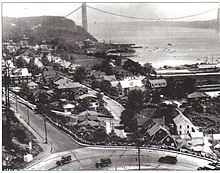 View of the bridge looking north from Edgewater, New Jersey, early 1931
View of the bridge looking north from Edgewater, New Jersey, early 1931The system of girders to support the deck was installed throughout 1930, and the last girder was installed in late December 1930.[104] In March 1931, the Port Authority announced that the Hudson River Bridge was set to open later that year, rather than in 1932 as originally planned. At that time, the Port Authority had opened bids for paving the road surface.[105] Later that month, the agency published a report, which stated that the bridge's early opening date was attributable to how quickly and efficiently the various materials had been transported.[106] In June 1931, forty bankers became the first people to cross the bridge.[107]
Work was progressing quickly on the bridge approaches in New Jersey,[108] and the New York City government was considering building another bridge between Manhattan and the Bronx (the Alexander Hamilton Bridge) to connect with the George Washington Bridge.[109] Bids for constructing tollbooths and floodlight towers were opened in July 1931.[110]
1930s to 1950s Opening The cover of the November 1931 edition of the Jester of Columbia, the humor magazine at Columbia University, celebrating the opening of the George Washington Bridge
The cover of the November 1931 edition of the Jester of Columbia, the humor magazine at Columbia University, celebrating the opening of the George Washington BridgeThe George Washington Bridge was dedicated on October 24, 1931, and the bridge opened to traffic on October 25, 1931, eight months ahead of schedule.[111][112] The opening ceremony, attended by 30,000 guests, was accompanied by a show from military airplanes, as well as speeches from politicians including Morgan Foster Larson, the governor of New Jersey, and Franklin D. Roosevelt, the governor of New York. The first people to cross the George Washington Bridge were reportedly two elementary school students who roller-skated across the bridge from the New York side.[112][113] Pedestrians were allowed to walk the length of the George Washington Bridge between 6 p.m. and 11 p.m. The bridge was formally opened to traffic the next day.[114] The Port Authority collected tolls for drivers who used the bridge in either direction; as with the Holland Tunnel, the toll was set at 50 cents for passenger cars, with different toll rates for other vehicle types.[114] Pedestrians paid a toll of 10 cents each, which was lowered to 5 cents in 1934.[115] Within the first 24 hours of the George Washington Bridge's official opening, 56,312 cars used the span, as well as 100,000 pedestrians (including those who had walked across after the ceremony).[114] The Port Authority reported that 33,540 pedestrians crossed the bridge on the first day, of which 20,000 paid a toll to cross.[116]
During the George Washington Bridge's construction, the cost of the bridge was estimated at $75 million,[117] and the bridge was expected to carry eight million vehicles and 1.5 million pedestrians in its first year of operation.[28] When the George Washington Bridge opened, it was estimated that eight million vehicles would use the bridge in its first year, and that the bridge could ultimately carry 60 million vehicles annually after a second deck was added. The bridge's final cost was estimated at $60 million.[118][119] Real-estate speculators believed that the bridge's construction would raise real-estate values in Fort Lee, since the borough's residents would be able to more easily access New York City. During the construction of the George Washington Bridge, speculators spent millions of dollars to buy land around the bridge's New Jersey approach.[120] The bridge was later credited with helping raise land prices and encouraging residential development in formerly agricultural parts of Bergen County. It also spurred the rise of the trucking industry along the United States' East Coast, supplanting much of the freight railroads that used to carry cargo.[121]
In the George Washington Bridge's first week of operation, the bridge carried 116,265 vehicles, compared to the Holland Tunnel's 173,010 vehicles, despite the fact that the tunnel had fewer lanes than the bridge did. During that time span, 56,000 pedestrians used the bridge.[122] A week after the bridge opened, the 10-lane tollbooth was expanded to 14 lanes because of heavy weekend traffic volumes.[123] In its first year of operation, the George Washington Bridge saw 5.5 million vehicular crossings and nearly 500,000 pedestrian crossings.[124] Traffic counts on the George Washington Bridge grew year after year. By the time of the bridge's tenth anniversary in 1941, the span had been used by 72 million vehicles total, including a record 9.1 million vehicles in 1940.[125]
Early modificationsNew Jersey Route 4, which connected directly to the bridge's western end, opened in July 1932.[126] The 178th-179th Street Tunnels, which connected Amsterdam Avenue on the eastern side of Manhattan to the bridge's eastern end on the west side of Manhattan, were supposed to be completed in late 1932.[127] Direct approaches to Riverside Drive and the Hudson River Parkway were completed in 1937,[46] and the tunnels were completed in 1938–1939. A ramp eastward from the bridge and southward to the Harlem River Drive was also completed around this time. On the New Jersey side, state highways were also being modernized to handle bridge traffic.[128] The bridge's westbound entrance ramp from Fort Washington Avenue, at the top of the cliff on the Manhattan side, opened in April 1939.[129] The corresponding eastbound exit ramp, as well as the 178th Street Tunnel, opened in June 1940. The 179th Street tunnel opened in 1950.[130]
Originally, the George Washington Bridge's single deck consisted of six lanes, with an unpaved center median. In 1946, the median was paved over and two more lanes were created on the upper level, widening it from six lanes to eight lanes.[131][119] The two center lanes on the upper level served as reversible lanes, which could handle traffic in either direction, depending on traffic flows.[132]
The bridge was initially lit by 200 lights to provide warning to pilots flying at night.[133] The Port Authority enacted a photography ban during World War II in the 1940s.[134] Additionally, from May 1942 to May 1945, the lights on the bridge were shut off at night as a precautionary measure. After the war ended, the lights were turned back on, but the photography ban was upheld.[135]
Lower deck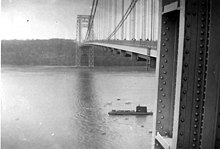 USS Nautilus passes under the bridge in 1956, when the bridge had only a single deck
USS Nautilus passes under the bridge in 1956, when the bridge had only a single deckThe completion of the George Washington Bridge's lower deck, as well as the construction of a new bus terminal and other highway connections near the bridge, were recommended in a 1955 study that suggested improvements to the New York City area's highway system. The lower deck was approved by the U.S. Army Corps of Engineers.[136][137] A Bergen County leader voted against the construction of the lower level in 1956, temporarily delaying construction plans.[138] The New York City Planning Commission approved the George Washington Bridge improvement in June 1957,[139] and the Port Authority allocated funds to the improvement that July.[140][141] The $183 million project included the construction of the lower deck; the George Washington Bridge Expressway, a 12-lane expressway connecting to the Alexander Hamilton Bridge and the Cross Bronx Expressway (later I-95 and US 9); the George Washington Bridge Bus Station above the expressway; and a series of new ramps to and from the Henry Hudson Parkway.[141][142] On the New Jersey side, two depressed toll plazas, one in each direction, were to be constructed for lower level traffic.[137][142] Highway connections were also being built on the New Jersey side, including a direct approach from I-95.[143]
Construction of the approaches started in September 1958.[132] Work on the lower level itself started on June 2, 1959,[89] but work was briefly halted later that year because of a lack of steel.[144] By February 1960, construction was underway on the lower level; the supporting steelwork for the future deck had been completed, and the sections for the lower deck were being installed.[141] The George Washington Bridge's lower deck would comprise 75 steel slabs; each slab weighed 220 tons and measured 108 feet (33 m) wide by 90 feet (27 m) feet long, with a thickness of 30 feet (9.1 m). The construction of the slabs proceeded from either side of the bridge.[132] The right-of-way for the George Washington Bridge Expressway had been almost entirely cleared except for the ventilation buildings for the 178th-179th Street Tunnels.[141] The segments of the lower deck had been laid completely by September 1960, at which point workers started pouring the concrete for the deck's roadway, a process that took five weeks.[145] The layer of concrete measured 4 inches (10 cm) thick.[132] Finally, the deck was paved over with a 2.5-inch (6.4 cm) layer of asphalt.[146][132]
New ramps to the George Washington Bridge in New Jersey, including from the newly completed I-95, opened in mid-1962.[147] The lower deck was opened to the public on August 29, 1962.[148][132] The lower level, nicknamed "Martha" after George's wife Martha Washington,[149][1] increased the capacity of the bridge by 75 percent,[132] and simultaneously made the George Washington Bridge the world's only 14-lane suspension bridge.[148][150] In addition to providing extra capacity, the lower level served to stiffen the bridge in high winds; before the lower deck was constructed, the George Washington Bridge was known to swing up to 30 inches (76 cm).[142] The George Washington Bridge Bus Station opened on January 17, 1963 and the Alexander Hamilton Bridge opened on January 15, 1963, thus allowing more traffic to use the George Washington Bridge.[151] In the first year after the lower level's opening, the expanded bridge had carried 44 million vehicles. By comparison, 35.86 million vehicles had crossed the bridge in an 11-month period between September 1, 1961 and July 31, 1962. In addition, traffic congestion at the George Washington Bridge was reduced after the lower level opened, and the Port Authority was able to make repairs to the upper level for the first time in the bridge's history.[152]
1970s to 1990s Lower deck
Lower deckA fixed median was added to the upper deck in the 1970s.[116] The bridge was carrying 82.8 million vehicles per year by 1980.[153] The George Washington Bridge was designated a National Historic Civil Engineering Landmark by the American Society of Civil Engineers on October 24, 1981, the 50th anniversary of the bridge's dedication ceremony.[154] The 50th anniversary was also marked with a parade of automobiles. At that point, 1.8 billion vehicles had used the bridge throughout its lifetime.[121]
In 1990, the Port Authority announced a minor rehabilitation for the George Washington Bridge. As part of the project, the supporting structural steel for the upper deck would be replaced, and some ramps would be rebuilt.[155] The ramps on the New York side, connecting with Riverside Drive and the Henry Hudson Parkway, were to be reconstructed for $27.6 million after studies in the late 1980s showed deterioration on these ramps.[156] Although the Port Authority had announced the repairs in advance, the start of roadwork in September 1990 caused extensive traffic jams.[157]
2000s to presentIn 2000, the Port Authority proposed building a ramp from the lower level to the Palisades Interstate Parkway on the New Jersey side.[158] Originally, the ramp would have cost $86.5 million and would have been completed in 2003 or 2004. However, the connection was ultimately not built.[159] The northern sidewalk was closed after the September 11 attacks in 2001 because of security concerns.[160]
 George Washington Bridge seen from Castle Village, shrouded in winter fog in December 2013
George Washington Bridge seen from Castle Village, shrouded in winter fog in December 2013In December 2011, the Port Authority announced plans to repair the bridge. For the first time, the vertical suspender ropes would be replaced, at an expected cost of more than $1 billion paid for by toll revenue.[161] On August 5, 2013, repair crews began an $82-million effort to fix cracks in upper-deck structural steel caused by traffic, particularly heavy trucks. The plan called for replacing 632 road deck panels, which would add at least 20 years of service life to the roadway. The work proceeded at night, and was slated to be complete by year's end. Delays prevented completion, and ultimately the work was halted for the winter.[162] Work restarted in June 2014 and was expected to last another 12 weeks.[163]
The Port Authority also started a $2 billion project to renovate or replace bridge components.[164][165] The lower level was repaved in 2016, and repainting work and maintenance platform replacement on the lower deck was completed in 2017.[166] The bridge's 592 vertical suspender ropes were then replaced to fix damage caused by excessive heat and humidity.[167][166] The staircases leading to the sidewalks on both the northern and southern sides of the upper deck were also being replaced with ramps that were compliant with the Americans with Disabilities Act of 1990. The Trans-Manhattan Expressway was being renovated in conjunction with this project.[166] On the New Jersey side, the Palisades Interstate Parkway cloverleaf ramp onto the eastbound George Washington Bridge would be replaced at a cost of $112.6 million by 2019. Two overpasses near the bridge would also be refurbished.[168][169] The northern sidewalk reopened in early 2023, after the suspender ropes on that side had been replaced.[160][165] By early 2024, the restoration project was half complete, and workers were restoring the southern sidewalk.[164]
Cite error: There are <ref group=lower-alpha> tags or {{efn}} templates on this page, but the references will not show without a {{reflist|group=lower-alpha}} template or {{notelist}} template (see the help page).
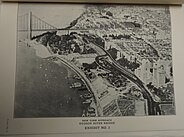
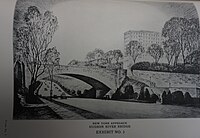
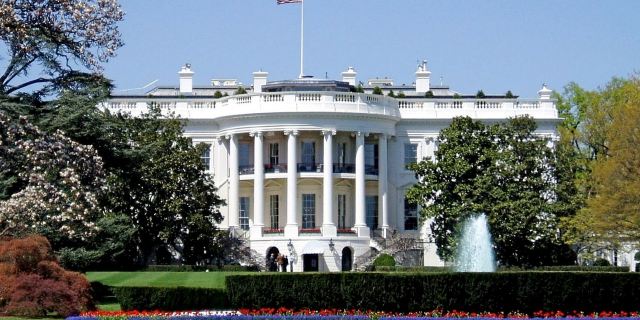

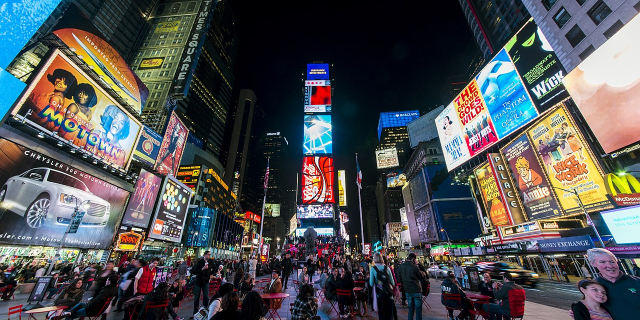











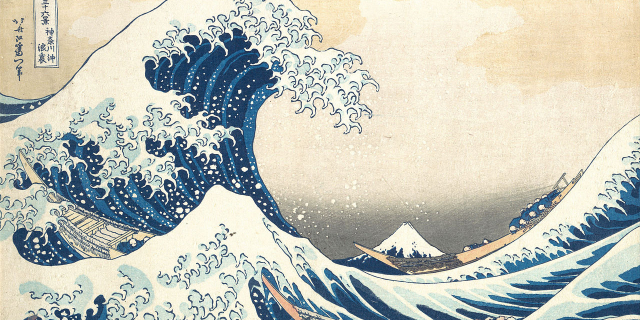


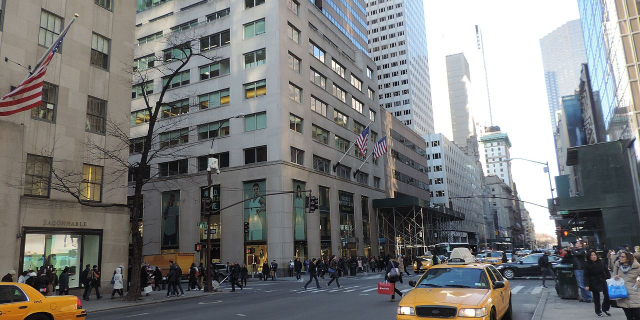
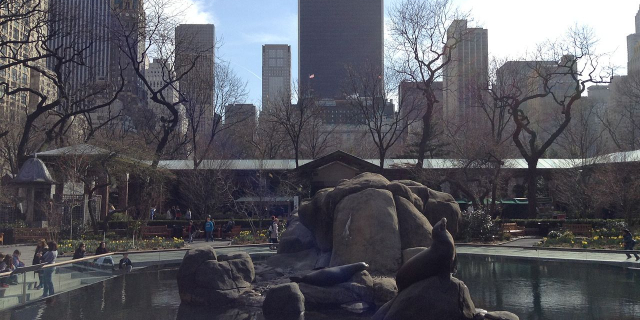
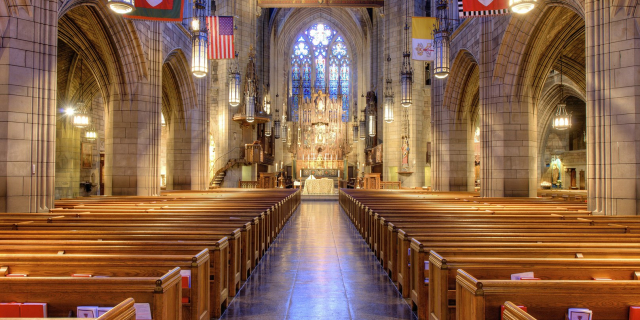




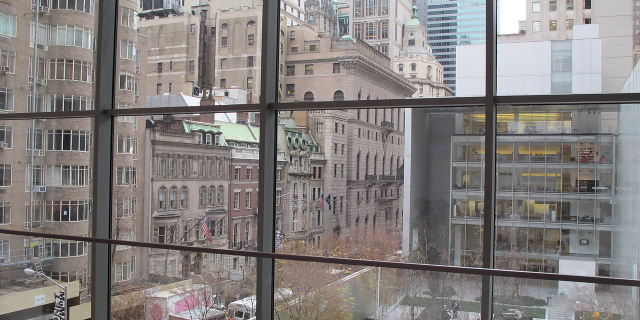
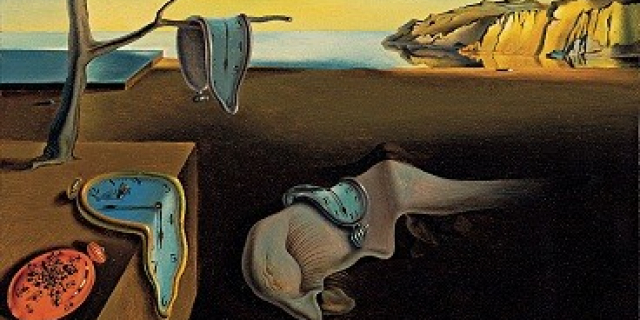




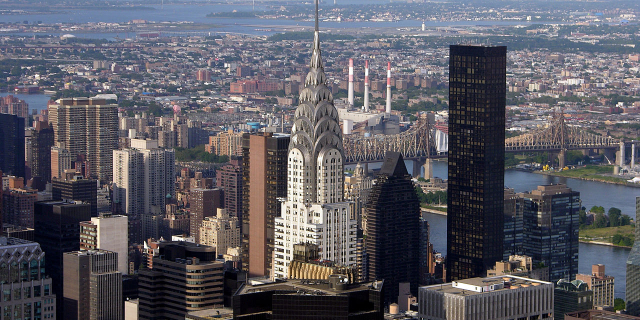

Add new comment